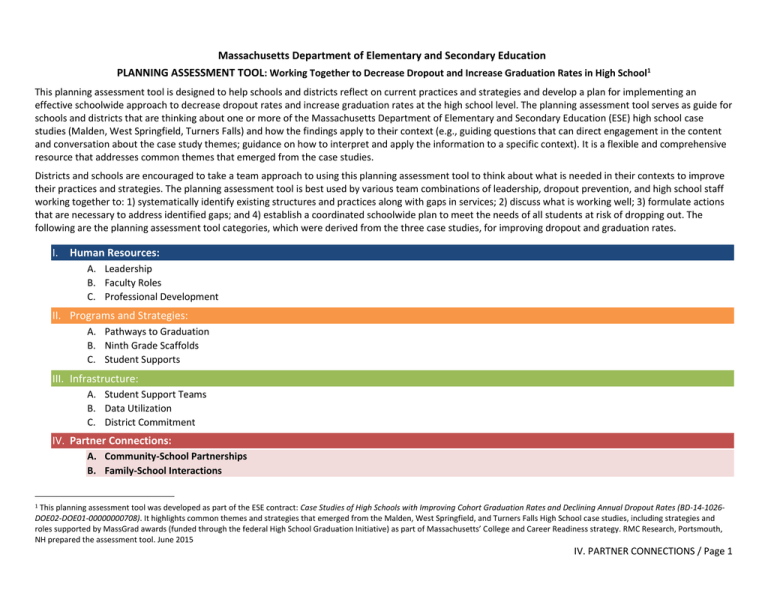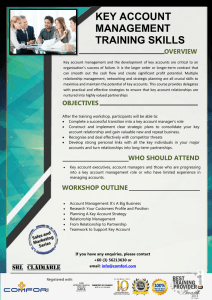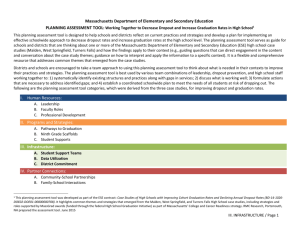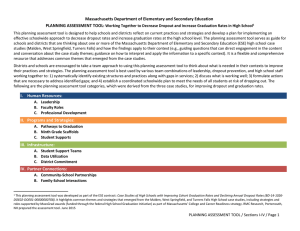2015 MA HSCaseStudyTool IV
advertisement

Massachusetts Department of Elementary and Secondary Education PLANNING ASSESSMENT TOOL: Working Together to Decrease Dropout and Increase Graduation Rates in High School1 This planning assessment tool is designed to help schools and districts reflect on current practices and strategies and develop a plan for implementing an effective schoolwide approach to decrease dropout rates and increase graduation rates at the high school level. The planning assessment tool serves as guide for schools and districts that are thinking about one or more of the Massachusetts Department of Elementary and Secondary Education (ESE) high school case studies (Malden, West Springfield, Turners Falls) and how the findings apply to their context (e.g., guiding questions that can direct engagement in the content and conversation about the case study themes; guidance on how to interpret and apply the information to a specific context). It is a flexible and comprehensive resource that addresses common themes that emerged from the case studies. Districts and schools are encouraged to take a team approach to using this planning assessment tool to think about what is needed in their contexts to improve their practices and strategies. The planning assessment tool is best used by various team combinations of leadership, dropout prevention, and high school staff working together to: 1) systematically identify existing structures and practices along with gaps in services; 2) discuss what is working well; 3) formulate actions that are necessary to address identified gaps; and 4) establish a coordinated schoolwide plan to meet the needs of all students at risk of dropping out. The following are the planning assessment tool categories, which were derived from the three case studies, for improving dropout and graduation rates. I. Human Resources: A. Leadership B. Faculty Roles C. Professional Development II. Programs and Strategies: A. Pathways to Graduation B. Ninth Grade Scaffolds C. Student Supports III. Infrastructure: A. Student Support Teams B. Data Utilization C. District Commitment IV. Partner Connections: A. Community-School Partnerships B. Family-School Interactions 1 This planning assessment tool was developed as part of the ESE contract: Case Studies of High Schools with Improving Cohort Graduation Rates and Declining Annual Dropout Rates (BD-14-1026DOE02-DOE01-00000000708). It highlights common themes and strategies that emerged from the Malden, West Springfield, and Turners Falls High School case studies, including strategies and roles supported by MassGrad awards (funded through the federal High School Graduation Initiative) as part of Massachusetts’ College and Career Readiness strategy. RMC Research, Portsmouth, NH prepared the assessment tool. June 2015 IV. PARTNER CONNECTIONS / Page 1 RATE CURRENT STATUS SCHOOL STRUCTURES, PRACTICES, STRATEGIES Fully in Place Partially in Place DISCUSSION NOTES Not Yet in Place (WHAT’S IN PLACE?) IV. PARTNER CONNECTIONS A. COMMUNITY-SCHOOL PARTNERSHIPS 1. The high school has established partnerships with community agencies that provide support for its programs and staff focused on dropout prevention. 2. The high school has developed partnerships with local postsecondary institutions to provide students with college and career readiness opportunities beyond that offered by the school (e.g., dual enrollment programs, campus visits, career guidance). 3. The high school has identified and formed partnerships with local businesses to provide students with mentoring, internships, or work-based learning opportunities beyond those offered by the school. 4. School leaders maintain ongoing communication with community partners about the school’s goals and needs. 5. All school staff are knowledgeable about the school’s partnerships, kept informed about services offered, and involved in the planning and integration of those services into the school’s programs focused on dropout prevention. 6. Community partners provide human resources that can remove burden from the school (e.g., in-kind services such as consulting, staff coaching and training, school and community professional development). IV. PARTNER CONNECTIONS / Community-School Partnerships / Page 2 RATE CURRENT STATUS SCHOOL STRUCTURES, PRACTICES, STRATEGIES Fully in Place Partially in Place DISCUSSION NOTES Not Yet in Place (WHAT’S IN PLACE?) IV. PARTNER CONNECTIONS A. COMMUNITY-SCHOOL PARTNERSHIPS 7. Community partners assist the school’s leadership with identifying potential funding streams to support and sustain the high school’s dropout prevention initiatives. 8. Community partnerships help the high school identify, recruit, and train adult advocates from the community who are invested in the success of students at risk of dropping out. 9. Community partnership activities outside of the school day provide students with additional opportunities to extend their learning and engagement (e.g., servicelearning, enrichment projects, team building experiences). IV. PARTNER CONNECTIONS / Community-School Partnerships / Page 3 PLANS FOR NEXT STEPS IV. PARTNER CONNECTIONS / A. COMMUNITY-SCHOOL PARTNERSHIPS 1. Review the discussion notes and identify common themes – Are there underlying needs (e.g., additional guidance staff) or common desired strategies (e.g., professional development in working with struggling students)? 2. Note the themes below and discuss priorities – Which approaches can be accomplished without additional resources and which require a longer-term strategy of reallocating resources? 3. Use that information to determine next steps – Consider a multi-prong strategy that will bring about some “quick wins” while you are working toward longer-term changes. IV. PARTNER CONNECTIONS / Community-School Partnerships / Page 4 RATE CURRENT STATUS SCHOOL STRUCTURES, PRACTICES, STRATEGIES Fully in Place Partially in Place DISCUSSION NOTES Not Yet in Place (WHAT’S IN PLACE?) IV. PARTNER CONNECTIONS B. FAMILY-SCHOOL INTERACTIONS 1. The high school offers multiple formats and venues for parents and families to build relationships with teachers and counselors as well as receive information about programs and services available to students who are at risk of dropping out (e.g., school orientations, community events, morning or evening gatherings, weekend school projects). 2. Staff continuously reach out to connect with all parents and families of at-risk students (e.g., in their homes or community locations, throughout the school year, and over the summer if indicated). 3. High school staff plan periodic events to celebrate student success with parents and extended families. 4. School staff view parents as partners in their work with students and are sensitive and responsive to family backgrounds and circumstances. 5. School staff share with all parents the school’s expectation of success for ALL students, make explicit how they are helping students move forward to graduation, and discuss student successes and learning needs. 6. For at-risk students who receive multiple services, parents have a single point of contact at the school who communicates a coordinated response from the team(s) working with their students. IV. PARTNER CONNECTIONS / B. Family-School Interactions / Page 5 PLANS FOR NEXT STEPS IV. PARTNER CONNECTIONS / B. FAMILY-SCHOOL INTERACTIONS 1. Review the discussion notes and identify common themes – Are there underlying needs (e.g., additional guidance staff) or common desired strategies (e.g., professional development in working with struggling students)? 2. Note the themes below and discuss priorities – Which approaches can be accomplished without additional resources and which require a longer-term strategy of reallocating resources? 3. Use that information to determine next steps – Consider a multi-prong strategy that will bring about some “quick wins” while you are working toward longer-term changes. IV. PARTNER CONNECTIONS / B. Family-School Interactions / Page 6





